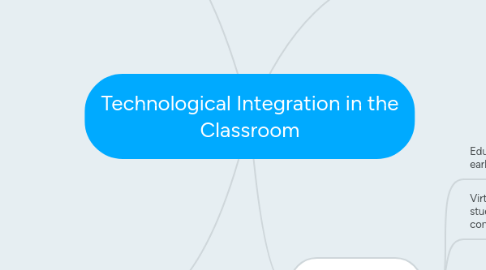Technological Integration in the Classroom
by staci zowty


1. Technological Tools
1.1. History
1.1.1. iCivics
1.1.2. Rollercoaster Tycoon
1.1.3. Civilization
1.1.4. The Big History Project
1.2. Science
1.2.1. WISE
1.3. Mathematics
1.3.1. National Library of Virtual Manipulatives
1.3.2. Shodor's Interactive
1.3.3. Cyberchase
1.3.4. The Adventure's of Jasper Woodbury
1.3.5. DimensionM
1.4. Reading
1.4.1. Read 180
1.4.2. Voyager Passport
1.4.3. Writing to Read
1.4.4. Between the Lions
1.4.5. Martha Speaks
2. Avoiding Pitfalls
2.1. Only 23 percent of teachers feel prepared to integrate technology into their classrooms
2.2. Technology can go awry
2.3. Research indicates that most kids cannot tell the difference between high and low credibility sources and do not know how to critically evaluate info on the internet
2.4. Only 43 percent of students feel prepared enough to use technology in their learning
3. Learning Outcomes
3.1. Blended learning works best - face to face with teacher as well as online
3.2. Replacing teachers entirely with online learning produces zero learning benefits
3.3. Based purely on how teachers implement technology to develop knowledge and skills
3.4. Students play an active role in their learning
4. Evidence Based Programs
4.1. Educational television develops early reading skills
4.2. Virtual mathematical manipulatives improves student understanding of mathematical concepts and attitudes towards math
4.3. Technology improves inquiry science based learning allowing student to:
4.3.1. Conduct virtual experiments
4.3.2. Generate and test models of complex data
4.3.3. Collect and analyze data using varying data analyzing software
4.3.4. Gather feedback from different sources to add too and refine scientific findings
